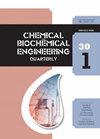Adsorption of Reactive Dyes from Aqueous Solution Using Activated Carbon Prepared from Plantain Leaf Sheath Waste
IF 0.9
4区 生物学
Q4 BIOTECHNOLOGY & APPLIED MICROBIOLOGY
引用次数: 3
Abstract
All parts of the plantain are widely used in India for various purposes. But plantain leaf sheath always ends up as waste material which accumulates as a biowaste. The present study focuses on the preparation of activated carbon using phosphoric acid as activating agent, and its efficacy as an adsorbent for the removal of reactive dyes, Reactive Green 19, and Reactive Red 141. Batch adsorption studies have been conducted and optimum adsorption conditions were determined as a function of contact time, initial dye concentration, adsorbent dosage, and pH. The experimental data were analyzed using Langmuir, Freundlich and Temkin isotherm models. The pseudo-first and second-order, intraparticle diffusion, and Elovich models were used to analyze the kinetic parameters of the adsorption system. Under the optimum conditions (initial dye concentration = 200 mg L–1, adsorbent dose = 1 g, pH = 2, contact time = 220 min for reactive green 19 and 180 min for reactive red 141), maximum percentage removal for reactive green 19 and reactive red 141 were obtained as 65.9 % and 72.7 %, respectively. The results demonstrate that activated carbon produced from chemical activation of the plantain waste has the potential of adsorbing reactive dyes from industrial effluents.车前草叶鞘废活性炭吸附水中活性染料的研究
大蕉的所有部分在印度被广泛用于各种目的。但车前草叶鞘往往以废弃物的形式积累为生物废弃物。本文主要研究了以磷酸为活化剂制备活性炭,并对其作为吸附剂去除活性染料活性绿19和活性红141的效果进行了研究。进行了批量吸附研究,确定了最佳吸附条件与接触时间、初始染料浓度、吸附剂用量和ph的关系。采用Langmuir、Freundlich和Temkin等温模型对实验数据进行了分析。采用拟一阶和二阶、颗粒内扩散和Elovich模型分析了吸附体系的动力学参数。在初始染料浓度为200 mg L-1,吸附剂剂量为1 g, pH = 2,接触时间为220 min(活性绿19)和180 min(活性红141)的条件下,活性绿19和活性红141的最大去除率分别为65.9%和72.7%。结果表明,用化学活化法制备的活性炭具有吸附工业废水中活性染料的潜力。
本文章由计算机程序翻译,如有差异,请以英文原文为准。
求助全文
约1分钟内获得全文
求助全文
来源期刊
CiteScore
2.70
自引率
6.70%
发文量
23
审稿时长
>12 weeks
期刊介绍:
The journal provides an international forum for presentation of original papers, reviews and discussions on the latest developments in chemical and biochemical engineering. The scope of the journal is wide and no limitation except relevance to chemical and biochemical engineering is required.
The criteria for the acceptance of papers are originality, quality of work and clarity of style. All papers are subject to reviewing by at least two international experts (blind peer review).
The language of the journal is English. Final versions of the manuscripts are subject to metric (SI units and IUPAC recommendations) and English language reviewing.
Editor and Editorial board make the final decision about acceptance of a manuscript.
Page charges are excluded.

 求助内容:
求助内容: 应助结果提醒方式:
应助结果提醒方式:


